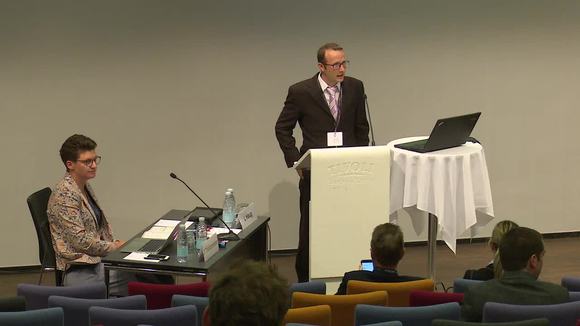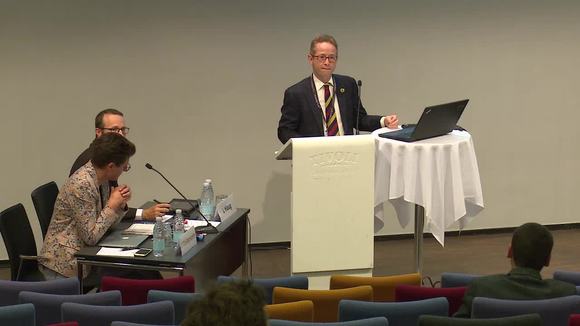Player is loading...
A-0547 A novel use of QR code stickers after orthopaedic plaster application
G Fieraru, AT Gough, R Middleton, P Gafney, M Butler, RJ Kincaid, Trauma and Orthopaedic Department, The Royal Cornwall Hospital, Truro, UK
Friday, June 15, 2018 · 3:18 p.m. · 07m 23s
Embed
Embed code is not allowed
This talk is part of a Private webcast, embeding is not permited.Transcriptions
Note: this content has been automatically generated.
00:00:01
no one uh thank you very much for the opportunity to present a small work from cornwall throw
00:00:07
in the united kingdom and thank you for that to your attention it audience and the panel
00:00:15
so what is it you are caught q. r. stands for quick reference and this has
00:00:20
been that a lot in japan in the nineteen nineties in the car industry
00:00:24
and its advantages that it has got much larger
00:00:28
data carrying capacity competitors in a bar code
00:00:31
so subsequently it became very popular in order industries
00:00:36
you are code can be easily scanned using smart phone some of them they come without editing starts off
00:00:43
well for some other of them we have a apps available for our us and and like platforms
00:00:50
and how this can be done advanced too or to be the contents surgery so in the n. h.
00:00:56
s. five years for or to view encourages patient centred cat and the use of mobile technology
00:01:03
and probably we can help this with the help of the q. r. code
00:01:07
and he is one example of what we did uh in cornwall we
00:01:15
yeah there are a lot uh q. r. code sticker which one
00:01:18
contained to emergency phone numbers for the patients as well
00:01:23
and uh this is how it looked like zoom zoom doubt
00:01:28
so the stickers they've been applied to every patient plaster cast a out
00:01:34
and uh before though to the patients off but then they returned to
00:01:39
always structured clinical be as those patients to complete the questionnaire
00:01:45
and uh in that question uh the the best then simple questions
00:01:50
well but if the patient decided to scan the barcode uh these has led them to
00:01:56
the hospital trust's website which one has got three main types in the first out
00:02:02
there was information about uh how to look after the cost how to care for it and what to look out for
00:02:09
in the second that that better contact the terrorists who can be contacted and band
00:02:15
they should be contacted and the turret that lead to some simple videos
00:02:20
how to avoid pressure was uh just how to care for
00:02:23
the cost and uh advice on rehabilitation as well
00:02:29
so the pilot project it was a prospective study in they said uh the patients but even
00:02:35
a questionnaire and then returned to fracture clinic a band the plaster cast was removed
00:02:41
and uh one of the patients they had a q. r. over the sticker applied
00:02:46
that ninety seven percent of the patients they still had the the sticker
00:02:50
on the cost at the time of the removal of the cost
00:02:54
and the only eighty percent of the patients but
00:02:57
given the cost information leaflet in fracture clinic
00:03:01
and uh on the follow up appointment only sixty five percent of the patients
00:03:07
still had the information leaflet order had an idea
00:03:11
about what was on the information leaflet
00:03:15
so eighty four percent uh or for the patients they better
00:03:18
body reassured of having information readily available on the cost
00:03:23
just in case if they need to contact someone or how to seek for that information
00:03:30
and then be as the patients if they have a smart phone because
00:03:34
going work population and these are the only it's a retirement area
00:03:39
so surprisingly only fifty five percent of the patients had the smart phone
00:03:44
but uh it was quite a surprise that nineteen percent
00:03:48
of the patients have actually scanned the barcode
00:03:52
and uh from uh all the patients only nine percent of them actually
00:03:57
contact that fractured clinic or a any for for that advice
00:04:03
so the nineteen percent of the patients who has actually scanned
00:04:07
the q. or codes they would mainly feet as the
00:04:10
early adopters in the technology life cycle and probably as
00:04:14
time goes by i will be more and more
00:04:18
and the technology use these expanding very rapidly
00:04:23
the majority of patients over sixty
00:04:25
five or changing do they they are accessing information by using smart phones
00:04:31
for example my ninety years old grandmother she uses
00:04:34
her mobile phone uh uh for phase book
00:04:40
so a future possible developments uh for this idea
00:04:44
you use to access operation information leaflets uh
00:04:49
uh for patients view surgeon and depend departmental profiles
00:04:54
and that possibly interpret patient x. rays and investigations
00:04:58
as all of our patients they have a bracelet who's in the hospital
00:05:03
having a barcode only to order q. or coordinate so it is very easy just to scan
00:05:08
it with a tablet and then easy access to all the imaging or the investigations
00:05:15
so in summary the patients they like the sticker it is but reliable and effective way
00:05:22
uh patients value or short and found the q. or codes to good use for it
00:05:27
and these supports the n. h. s. five year forward view
00:05:32
and the patients they can access so they information not
00:05:35
retained in that consultation twenty four hours a day
00:05:40
oh yeah these are my references and uh i
00:05:44
have no conflict of interests in this project
00:05:48
if anybody wants to scan it was good to go
00:05:52
and it didn't talk yes okay thank you very much and question ha ha
00:06:05
i think you're what is innovative approach eight
00:06:11
are you still going alright their stories it was just a trial and then now we stop
00:06:16
it or is it no no it has been ruled out onto onto the fortress
00:06:21
or the patience enjoy cornwall hospital they are having the q. output sticker applied to that point
00:06:27
to the plaster caster and if you're using them on backs up
00:06:32
and now they are rolling out onto the words as well so patients
00:06:36
they can access the information about their surgery about the recovery okay
00:06:43
okay it's definitely a good sense publications but dead impression doesn't decrease or
00:06:49
increase yeah my contacts they have their own number yep i to
00:06:55
yeah if i didn't look into those exact statistic numbers
00:07:01
uh bought it uh uh as you said it's
00:07:06
it's a good service for the patients and uh all work yeah it is very patient centred
00:07:12
and i'm not sure if the number of phone calls has increased to the hospital or not
Conference Program
A-1233 What do we expect from FESSH
Luzian Haug, Bern, Switzerland
June 15, 2018 · 1:59 p.m.
A-1233 What do we expect from FESSH - Q&A
Luzian Haug, Bern, Switzerland
June 15, 2018 · 2:04 p.m.
A-1240 How to get your paper published
Grey Giddins , UK
June 15, 2018 · 2:05 p.m.
124 views
A-1240 How to get your paper published - Q&A
Grey Giddins , UK
June 15, 2018 · 2:22 p.m.
A-0792 Interobserver Reliability Study of the Classification of Scaphoid Waist Fractures using Computer-Tomography
Rasmus Wejnold Jørgensen, Anders Klahn, Johannes Heindl, Lars Solgård, Lars Vadstrup, Dejan Susic, Robert Gvozdenovic, Stig Jørring, Claus Hjorth Jensen, Hand Clinic, Department of Orthopedics, Herlev-Gentofte University Hospital of Copenhagen, Denmark
June 15, 2018 · 2:23 p.m.
A-0237 Neuropathic pain after repair of brachial plexus injury : a 30-year follow-up of the Narakas' series
Swenn Maxence Krähenbühl, Chantal Bonnard, Laurent Wehrli, Lausanne University Hospital, Lausanne, Switzerland
June 15, 2018 · 2:29 p.m.
A-0482 Pisiform Excision; a solution for a long-term ulnar sided wrist pain. A retrospective analysis, comparing pre- and postoperative measurements
M.V. van Burink, S. Al Shaer, J. van Rossen, A. Fink, H. Slijper, T. M. Moojen, H. Rakhorst, G. van Couwelaar, R. Feitz, O.T. Zöphel, Xpert Clinic, The Netherlands
June 15, 2018 · 2:35 p.m.
2025 views
A-1075 Extensor tendons adhesions: the role of different anti-adherent agents. Preliminary evidences from an Italian multicentric study.
Alfio L Costa, University of Messina, Department of Human Pathology of the Adult, the Child and the Adolescent, Messina, Italy
June 15, 2018 · 2:42 p.m.
A-0328 Prevalence of the Linburg–Comstock Anomaly in Women with Carpal Tunnel Syndrome
Saulo Rodrigues Moreira, Carlos Henrique Fernandes, Lia Myamoto Meirelles, Luis Renato Nakachima, João Baptista Gomes dos Santos, Flavio Fallopa, Hospital São Paulo/Universidade Federal de São Paulo/ Department of Orthopedic Surgery/ Hand Surgery Unit, Brazil
June 15, 2018 · 2:51 p.m.
112 views















